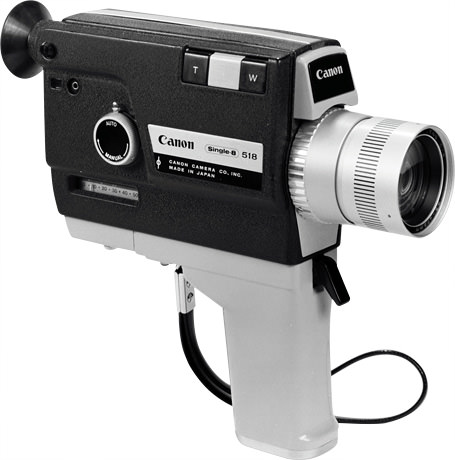 Japan
Japan Americas
Americas Europe, Asia, Oceania
Europe, Asia, Oceania
- Outline
- Specifications
| Marketed | December 1965 |
| Original Price | 39,500 yen |
Fuji Photo Film Co., Ltd. announced a new 8mm film standard–Single 8–at about same time as Super 8. The film format was the same as the Kodak Super 8, but the shape of the cartridge was quite different. The Kodak Super 8 system had the largest share of the global market, but Single 8 models were developed mainly for the Japanese market. Maximized parts reuse from Super 8 models to Single 8 models was studied at the R&D stage. The cartridge-loading methods of Super 8 and Single 8 systems were symmetrical. For this reason, designing a reversed Super 8 model as a Single 8 model was once studied. Actually, a test model with the viewfinder on underside of the camera, was produced, but it was not easy to handle, and this idea was abandoned.
This model had the same specifications as the Zoom 518 Super 8 (marketed in 1964), but it had a very stiff design with a battery compartment on the die-cast exterior and a fixed grip. This camera had a rewinding crank, which was unique to the Single 8 system, and it was accepted by many 8mm movie camera lovers.
| Type | Single 8 type 8mm movie camera | |
| Image Size | 4.2 x 5.7 mm (Projection image size: 4 x 5.4mm) | |
| Film | Single 8 film cartridge | |
| Lens | Focal Length/Speed | 9.5 – 47.5mm f/1.8 (14 elements in 11 groups, including 5 new type glass elements) Coating: Composite spectra coating of amber and magenta. Focal length can be extended to 15.6 – 78mm f/1.8 with the Tele Converter 1.6X. |
| Zooming Ratio | 5x | |
| Focusing | Manual (Front lens group rotating method), 1.2 m to infinity | |
| Zooming | Power zooming (Approx. 6 sec.), manual zooming with zooming ring. Rotation angle of approx. 100 degrees. | |
| Filter Size | 48 mm | |
| Viewfinder | Type | Single-lens reflex type |
| Rangefinder | Prism screen rangefinder (Micro-prism rangefinder) | |
| Dioptric Adjustment | -3 to +1 diopter | |
| Viewfinder Information | Aperture value, exposure meter needle, over/under exposure warnings | |
| Exposure Control | Type | Automatic aperture setting coupled to loaded film speed and shooting speed (manual aperture setting possible) |
| Exposure Meter | Built-in TTL CdS exposure meter | |
| Metering Range | ISO 200 f/1.8, 18 fps – ISO 16 f/16, slow motion | |
| Film Speed | ISO 16, 25, 50, 100 and 200, automatic setting with the cartridge | |
| Power Source | Two MD mercury cells | |
| Battery Check | Push button checking | |
| Film Drive | Type | Power filming |
| Filming Speed | 18 fps and slow motion (about 36 fps) | |
| Power Source | Four 1.5 V AA batteries contained in the grip (sufficient power for approximately 10 film cartridges under normal temperature) | |
| Footag Counter | Counts up. Automatic resetting. Rewinding number per one foot indicated. Checking window for film type and driving. | |
| Battery Check | Push button checking | |
| Rewinding Mechanism | Manual rewinding with rewinding crank. Used also for fading out/in double exposure. | |
| Shutter | Shutter Opening | 160 degrees |
| Shutter Lock Dial | Three positions for safety lock, run, running lock/remote control | |
| Safety Mechanism | Safety mechanisms such as exposure warning, shutter lock and film drive confirmation | |
| Remote Control | Possible with remote switch | |
| Grip | Fixed grip, battery compartment for driving AA batteries. | |
| Dimensions (W x H x D) | 56 x 206 x 196 mm | |
| Weight | 1,350 g (Body only) | |


